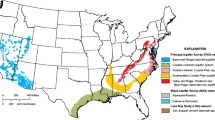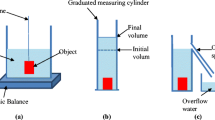Abstract
Factors affecting viable cell counts in groundwater or sediments were studied with samples from the Segeberg Forest test area in northern Germany. There was very little variation in results with the season (April, August, November) or depth of sampling; generally there were 103−104 aerobic cells per ml or g sediment. Long incubation times resulted in higher cell counts; groundwater samples required 4–5 weeks, and sediment extracts had to be cultured for 7 weeks. Total cell counts in sediment were 102−104 cell/g higher than viable cell counts of aerobes. This was explained partly by the additional presence of anaerobes and partly by the observation that some morphotypes may not have grown under our conditions. Viable cell counts were not influenced by cell extraction from the sediment with either Na-pyrophosphate or groundwater extracts. However, iron-precipitating or manganese-oxidizing bacteria were better extracted with sterile groundwater. The microflora of wells was more numerous than that of the free aquifer; consequently it was better to pump off all well water before aquifer water was sampled. The diameter of the well was also important; thinner tubes had higher cell counts than those with wider diameter. For sampling, wells should be at least 1 year old, since young wells contain higher numbers of microorganisms due to underground disturbances from the drilling. Turbid water samples could be clarified by filtration, but this reduced the viable counts by 1–2 orders of magnitude. Two different media inoculated with a sample dilution resulted in the same cell counts, but their microbial diversity was different. Storage of groundwater samples before processing resulted in up to 17-fold increases in cell counts and loss of diversity in the first 24 hours. Cell numbers decreased slowly during longer storage.
Similar content being viewed by others
References
Balkwill DL, Rucinsky TE, Casida LE Jr (1977) Release of microorganisms from soil with respect to transmission electron microscopy viewing and plate counts. Antonie v Leeuwenhoek 43:73–81
Dommergues Y, Duchauffour P (1965) Étude comparative de la dégradation biologique des complèxes organo-ferriques dans quelques types des sols. Science du sol 1:43–59
Ghiorse WC, Balkwill DL (1982) Microbiological characterization of subsurface environments. Proc 1st Intl Conf on Groundwater Quality Research. Ward CH, Giger W (eds) Wiley Interscience Publishing Co, New York, 387–401
Havemeister G, Riemer R, Schröter J (1983) Lebensdauer und Transport von Bakterien in typischen Grundwasserleitern-Glazifluviatile Sande im Segeberger Forst. Forum Mikroorganismen u Viren in Grundwasserleitem, München 1983. DVGW Schriftenreihe Wasser 35: 151–162
Hirsch P, Rades-Rohkohl E (1983a) Microbial diversity in a groundwater aquifer in Northern Germany. Industr Microbiol 24:183–200
Hirsch P, Rades-Rohkohl E (1983b) Die Zusammensetzung der natürlichen Grundwasser-Mikroflora und Untersuchungen über ihre Wechselbeziehungen mit Fäkalbakterien. Forum Mikroorganismen u Viren in Grundwasserleitern, München 1983; DVGW Schriftenreihe Wasser 35:59–80
Hoos E, Schweisfurth R (1982) Untersuchungen über die Verteilung von Bakterien von 10 bis 90 Meter unter Boden-Oberkante. Vom Wasser 58:103–112
Kölbel-Boelke J, Tienken B, Nehrkorn A (1988a) Microbial communities in the saturated groundwater environment. I. Methods of isolation and characterization of heterotrophic bacteria. Microb Ecol 16:17–29
Kölbel-Boelke J, Anders EA, Nehrkorn A (1988b) Microbial communities in the saturated groundwater environment. II. Diversity of bacterial communities in a pleistocene sand aquifer (Bocholt, Westfalia, FRG) and their in vitro activities. Microb Ecol 16:31–48
Schweisfurth R (1968) Untersuchungen über manganoxidierende und -reduzierende Mikroorganismen. Mitt Internat Verein Limnol 14:179–186
Schweisfurth R (1972) Manganoxidierende Mikroorganismen in Trinkwasser-Versuchsanlagen. GWF Wasser/Abwasser 113:562–572
Skerman VBD (1967) Guide to the identification of the genera of bacteria. Williams & Wilkins Co, Baltimore
Staley JT (1968)Prosthecomicrobium andAncalomicrobium: new prosthecate freshwater bacteria. J Bactcriol 95:1921–1942
Wieringa KT (1966) Solid media with elemental sulphur for detection of sulphuroxidizing microbes. Ant v Leeuwenhoek 32:183–186
Wilson JT, McNabb JF, Balkwill DL, Ghiorse WC (1983) Enumeration and characterization of bacteria indigenous to a shallow watertable aquifer. Ground Water 21:134–142
Zimmermann R, Iturriaga R, Becker-Birch J (1978) Simultaneous determination of the total number of aquatic bacteria and the number thereof involved in respiration. Appl Environ Microbiol 36:926–935
Author information
Authors and Affiliations
Rights and permissions
About this article
Cite this article
Hirsch, P., Rades-Rohkohl, E. Some special problems in the determination of viable counts of groundwater microorganisms. Microb Ecol 16, 99–113 (1988). https://doi.org/10.1007/BF02097408
Issue Date:
DOI: https://doi.org/10.1007/BF02097408




